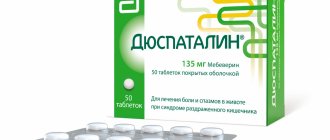Pharmacological properties of the drug Tamsulosin
A selective and competitive blocker of postsynaptic α1A-adrenergic receptors located in the smooth muscles of the prostate gland, bladder neck and prostatic urethra, reduces their tone and improves urine outflow. At the same time, it reduces the severity of symptoms of obstruction and irritation caused by benign prostatic hyperplasia. As a rule, the therapeutic effect develops 2 weeks after starting tamsulosin. The selectivity of tamsulosin for α1A-adrenergic receptors is 20 times greater than that for α1B-adrenergic receptors located in vascular smooth muscle. Due to its high selectivity, tamsulosin does not cause any clinically significant reduction in systemic blood pressure in both patients with hypertension (arterial hypertension) and in patients with normal baseline blood pressure. After oral administration, tamsulosin is quickly and almost completely absorbed from the digestive tract. Bioavailability is about 100%. After a single oral dose of 400 mcg, the maximum concentration in the blood plasma is achieved after 6 hours. At steady state (5 days after the start of treatment), the maximum concentration of the active substance in the blood plasma is 60–70% higher than after a single dose . 99% of tamsulosin binds to plasma proteins. The volume of distribution is insignificant and amounts to 0.2 l/kg. Slowly metabolized in the liver to form pharmacologically active metabolites that retain high selectivity for α1A-adrenergic receptors. Most tamsulosin is found in the blood unchanged. Excreted by the kidneys, 9% unchanged. The half-life for a single dose is 10 hours, the terminal half-life is 22 hours.
Tamsulosin
As with the use of other alpha1-blockers, during treatment with tamsulosin, in some cases a decrease in blood pressure may be observed, which can sometimes lead to fainting. At the first signs of orthostatic hypotension (dizziness, weakness), the patient should sit or lie down and remain in this position until the signs disappear.
Before prescribing tamsulosin therapy, it is necessary to exclude the presence of other diseases in the patient that can cause the same symptoms as benign prostatic hyperplasia.
Before starting treatment and regularly during therapy, a digital rectal examination and, if necessary, determination of prostate specific antigen (PSA) should be performed.
Treatment with tamsulosin in patients with severe renal failure (creatine clearance less than 10 ml/min) requires caution, because No studies have been conducted in this category of patients.
In some patients taking or previously taking tamsulosin. During surgery for cataracts or glaucoma, it is possible to develop intraoperative instability syndrome of the iris (narrow pupil syndrome), which can lead to complications during surgery or in the postoperative period. The advisability of discontinuing tamsulosin therapy 1-2 weeks before surgery for cataracts or glaucoma has not been proven. Cases of intraoperative instability of the iris occurred in patients who stopped taking the drug earlier before surgery. It is not recommended to initiate tamsulosin therapy in patients scheduled for cataract or glaucoma surgery. During the preoperative examination of patients, the surgeon and ophthalmologist should consider whether the patient is taking or has taken tamsulosin. This is necessary to prepare for the possibility of developing intraoperative iris instability syndrome during surgery. If angioedema develops, drug therapy should be discontinued immediately. Repeated administration of tamsulosin is contraindicated.
In case of renal failure, as well as in case of mild and moderate liver failure, no dosage adjustment is required.
There are reports of cases of the development of prolonged erection and priapism during therapy with alpha1-blockers. If an erection persists for 4 hours, you should immediately seek medical help. If priapism therapy is not carried out immediately, it can lead to damage to the tissue of the penis and irreversible loss of potency.
Tamsulosin overdose, symptoms and treatment
Acute overdose of tamsulosin has not been described. Theoretically, after an overdose, there is a risk of developing acute arterial hypotension, which may require additional cardiotropic therapy. If the symptoms are not eliminated, you should replenish the blood volume by prescribing electrolyte solutions, or administer vasoconstrictor drugs. To prevent further absorption of tamsulosin, gastric lavage should be performed, activated charcoal and an osmotic laxative should be prescribed.
List of pharmacies where you can buy Tamsulosin:
- Moscow
- Saint Petersburg
Tamsulosin Bacter, 0.4 mg, enteric capsules with prolonged release, 30 pcs.
As with the use of other alpha-1-blockers, when treated with Tamsulosin Canon, in some cases a decrease in blood pressure may be observed, which can sometimes lead to fainting. At the first signs of orthostatic hypotension (dizziness, weakness), the patient should sit or lie down and remain in this position until these symptoms disappear.
Before starting tamsulosin therapy, the patient should be examined to exclude the presence of other diseases that may cause the same symptoms as benign prostatic hyperplasia. Before starting treatment and regularly during therapy, a digital rectal examination and, if required, a prostate specific antigen (PSA) determination should be performed.
There are reports of cases of the development of prolonged erection and priapism during therapy with alpha1-blockers. If an erection persists for more than 4 hours, you should immediately seek medical help. If priapism therapy is not carried out immediately, it can lead to damage to the tissue of the penis and irreversible loss of potency.
Treatment with Tamsulosin Canon in patients with severe renal failure (creatinine clearance).
Some patients taking or previously taking tamsulosin during surgery for cataracts or glaucoma may develop intraoperative iris instability syndrome (narrow pupil syndrome), which can lead to complications during surgery or in the postoperative period. The advisability of discontinuing tamsulosin therapy 1-2 weeks before surgery for cataracts or glaucoma has not been proven. Cases of intraoperative iris instability occurred in patients who stopped taking the drug and earlier before surgery. It is not recommended to initiate tamsulosin therapy in patients scheduled for cataract or glaucoma surgery. During the preoperative examination of patients, the surgeon and ophthalmologist should consider whether the patient is taking or has taken tamsulosin. This is necessary to prepare for the possibility of developing intraoperative iris instability syndrome during surgery.
If angioedema develops, drug therapy should be discontinued immediately. Repeated administration of tamsulosin is contraindicated.
Impact on the ability to drive vehicles and machinery.
Caution must be exercised when driving vehicles and engaging in potentially hazardous activities that require increased concentration and speed of psychomotor reactions, due to the fact that dizziness may develop when taking tamsulosin.
Tamsulosin-LF capsules with modified release 0.4 mg No. 10x3
Name
Tamsulosin-LF capsule with MV 0.4 mg in container pack No. 10x3
Description
Hard gelatin capsules No. 1 are cylindrical in shape with hemispherical ends with a white body and a green cap.
Main active ingredient
Tamsulosin
Release form
Modified release capsules.
Dosage
0.4 mg
special instructions
As with the use of other β1-adrenergic receptor blockers, in some cases, when using Tamsulosin-LF, a decrease in blood pressure is possible, which can sometimes lead to loss of consciousness. When the first signs of orthostatic hypotension appear (dizziness, weakness), the patient should take a horizontal position until the above symptoms disappear. Before starting treatment with Tamsulosin-LF, it is necessary to undergo a medical examination to identify other concomitant diseases that can cause the same symptoms as benign prostatic hyperplasia. Before starting treatment, it is necessary to conduct a rectal examination of the prostate gland and, if necessary, a test to determine the level of prostate specific antigen (PSA) before the start and at regular intervals during treatment. Prescribe the drug to patients with severe renal failure (creatinine clearance
Pharmacotherapeutic group
Means for the treatment of urological diseases. Drugs for the treatment of benign prostatic hyperplasia. Alpha adrenergic receptor antagonists. Tamsulosin.
Indications for use
Treatment of functional symptoms in benign prostatic hyperplasia.
Directions for use and doses
For oral administration. Adults and children over 18 years of age are recommended to take 1 capsule per day, after breakfast, with plenty of water, without chewing or breaking. Patients with impaired liver and kidney function. In case of renal failure, as well as in case of mild to moderate liver failure, no dosage adjustment is required.
Use during pregnancy and lactation
The drug is used only for the treatment of men.
Use in children
The drug is not used in children under 18 years of age.
Impact on the ability to drive vehicles and operate machinery
The effect of the drug on the ability to drive vehicles or operate other machinery has not been studied. Patients should be warned about the possibility of dizziness.
Interaction with other drugs
When tamsulosin hydrochloride was used simultaneously with atenolol, enalapril, nifedipine or theophylline, no drug interactions were observed. Concomitant use with cimetidine increases and with furosemide reduces the concentration of tamsulosin in the blood plasma, but since these levels remain within normal limits, there is no need for special dose adjustment of tamsulosin. In in vitro studies, diazepam, propranolol, trichlormethiazide, chlormadinone, amitriptyline, diclofenac, glibenclamide, simvastatin and warfarin did not affect the free fraction of tamsulosin in blood plasma. Similarly, tamsulosin does not change the level of free fractions of diazepam, propranolol, trichlormethiazide and chlormadinone in human plasma. In vitro studies did not reveal interactions at the level of hepatic metabolism with the participation of microsomal fractions in the liver (indicative was the enzymatic metabolism system with the participation of cytochrome P450) regarding amitriptyline, salbutamol, glibenclamide and finasteride. However, diclofenac and warfarin may accelerate the elimination of tamsulosin from blood plasma. Co-administration of tamsulosin with strong inhibitors of the CYP3A4 isoenzyme may lead to increased concentrations of tamsulosin. Co-administration with ketoconazole resulted in an increase in AUC and Cmax of tamsulosin by 2.8 and 2.2 times, respectively. The combination of tamsulosin with strong CYP3A4 inhibitors should not be used in patients with impaired metabolism of the CYP2D6 isoenzyme. The drug should be used with caution in combination with strong and moderate CYP3A4 inhibitors. The simultaneous administration of tamsulosin and paroxetine led to an increase in the AUC and Cmax of tamsulosin by 1.3 and 1.6 times, respectively, but this increase was considered clinically insignificant. Concomitant use with other β1-adrenergic receptor blockers may enhance the hypotensive effect.
Contraindications
- hypersensitivity to the active substance or any of the auxiliary components of the drug;
- orthostatic hypotension (including history);
- severe liver failure.
With caution: severe renal failure (creatinine clearance less than 10 ml/min).
Compound
Each capsule contains: Active substance: tamsulosin hydrochloride (in the form of pellets 0.2%) – 0.4 mg; Excipients: sugar granules, medicinal coating L100 (methacrylic acid - methyl methacrylate copolymer), macrogol 6000, ethylcellulose; Composition of hard gelatin capsule: crimson 4R (E 124), orange yellow (E 110), quinoline yellow (E 104), patent blue V (E 131), titanium dioxide (E 171), gelatin.
Overdose
There have been no cases of acute overdose with tamsulosin. Symptoms: the development of an acute decrease in blood pressure and compensatory tachycardia is possible. Treatment: symptomatic, maintenance therapy should be carried out aimed at restoring normal function of the cardiovascular system (for example, the patient must take a horizontal position). If this measure does not work, infusion therapy is carried out and vasopressors are prescribed. It is necessary to monitor renal function and provide general supportive therapy. Due to the high degree of binding of tamsulosin to plasma proteins, hemodialysis is not advisable. In order to stop further absorption of the drug, vomiting can be artificially induced. In case of an overdose of a significant amount of the drug, the patient must rinse the stomach using activated charcoal and low-osmotic laxatives such as sodium sulfate.
Side effect
When taking tamsulosin, there is a possibility of developing adverse reactions, which are classified according to organ systems and frequency of occurrence: very often (>1/10), often (>1/100; 1/1000;
- from the central nervous system: dizziness (1.3%);
- from the reproductive system: ejaculation disorders.
- from the central nervous system: headache;
- from the cardiovascular system: palpitations, postural hypotension;
- from the respiratory system, chest and mediastinum: rhinitis;
- from the gastrointestinal tract: constipation, diarrhea, nausea, vomiting;
- on the part of the skin and mucous membranes: skin rash, urticaria, itching;
- general disorders: asthenia.
Uncommon side effects:
Rare side effects:
- from the central nervous system: fainting;
- from the skin and mucous membranes: angioedema
Very rare side effects:
- from the reproductive system: priapism.
- from the skin and mucous membranes: Stevens-Johnson syndrome.
Cases of intraoperative instability of the iris (constricted pupil syndrome) during cataract surgery in patients who have been taking tamsulosin for a long time have been described.
Storage conditions
In a place protected from moisture and light at a temperature not exceeding 25°C. Keep out of the reach of children.


